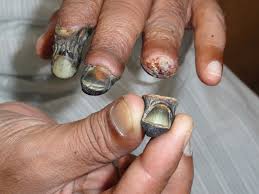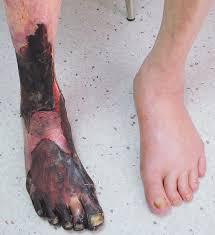Gangrene – Cell death or necrosis is a condition in which the body tissue dies due to lack of blood supply caused due to infection or any physical trauma or any chronic health affecting blood circulation. It is a life threatening problem; the death of the tissue is called as necrosis. Diabetes and smoking increases the risk of having gangrene. Necrosis occurs mostly in the body lower extremities like legs and feet, it can also occur in fingers, intestine etc.
Blood is an important connective tissue in the body; it acts as a carrier and connects all the parts of the body by supplying oxygen, nutrients, hormones etc. It also plays an important role in maintaining the body temperature, which is an important factor for many metabolic processes. Therefore if there is any discrepancy in this blood supply to any tissue or body part, severe damage happens if not treated soon. The cells die slowly and cannot be replaced.
There are two different types of gangrene
Table of Contents
Wet gangrene
Wet gangrene is more dangerous than dry. It is caused due to severe physical trauma which can cut off the blood supply easily and can cause infection too. Due to the infection pus is formed, that is the reason it is called as wet gangrene and chances are there for spreading of the infection. This is very fatal if not treated soon.
Dry gangrene
Dry gangrene as the name suggests this type of gangrene the tissue becomes dry and scaly. It is often seen in diabetic and autoimmune disordered people. It mainly is seen in toes and feet. The tissue become dry, it changes colour due to lack of blood supply, becomes blue to black and finally it is autoamputated. Infection is not seen in dry gangrene but once infection occurs it changes to wet gangrene.
Signs and symptoms
- Skin at the affected areas becomes shiny and dry.
- Shedding of the top layers of the skin

- Clear cut difference between the tissue affected and healthy tissue
- Skin colour changes from brown to blue and then black
- In wet gangrene the tissue infected has blisters of pus and the smell is foul
- The tissue becomes cold and looses its sensation and movement is stopped.
- The arteries present at the tissue loose their pulse.
Treatment
- The method of treatment is generally determined by the location of affected tissue and extent of tissue loss. The best treatment for gangrene is revascularization (i.e., restoration of blood flow) of the afflicted organ, which can reverse some of the effects of necrosis and allow healing.
- Other treatments include antibiotic therapy, wound care, debridement and surgical amputation.
- Angioplasty should be considered if severe blockage in lower leg vessels (tibial and peroneal artery) which leads to gangrene

